Fiasco Italo-Brittanico
Part 18: The end of the road for March in CART and as a whole
Author
- Henri Greuter
Date
- August 4, 2009
Related articles
- March-Alfa Romeo 90CA - Fiasco Italo-Brittanico, by Henri Greuter
- Introduction
- Part 1: Alfa's inverse Midas touch
- Part 2: Indy teams keep on March-ing
- Part 3: The Indy project that became a blackmail project
- Part 4: Patrick Racing, a brief history up to 1989
- Part 5: 1989 - Alfa picking up the pieces
- Part 6: 1989 - Winning major prizes on the road to losing everything
- Part 7: 1989 - The first Alfa Romeo-powered CART racer
- Part 8: 1989 - A hopeful start for Alfa Romeo
- Part 9: Preparing for 1990
- Part 10: The 90CA in more detail
- Part 11: Exhaust solutions a 'waste' of effort?
- Part 12: 90CA on active duty - up to halfway into the month of May
- Part 13: 90CA on active duty - the early part of the second week of practice at Indianapolis
- Part 14: 90CA on active duty - wrestling through the second week of practice and qualifying
- Part 15: 90CA on active duty - about the Alfa Romeo V8 engine
- Part 16: 90CA on active duty - the last part of 'Indianapolis'
- Part 17: 90CA on active duty - after Indianapolis
- Part 19: The left-over hardware and where to find it
- Part 20: Final verdict on the March-Alfa Romeo 90CA
- Appendix I: Specifications
- Appendix II: Results and scores
- Appendix III: March-Alfa Romeo 90CA-related collectables and memorabilia
- March-Porsche 90P - The last oddball at the Indianapolis Motor Speedway, by Henri Greuter
Who?Roberto Guerrero What?Lola-Buick T92/00 Where?Indianapolis When?1994 Indianapolis 500 |
 |
Why?
At about the same time, March saw both factory-supported CART projects coming to an end. Less than two months after March lost the Alfa deal, Porsche decided to stop their CART adventures in order to concentrate on Formula One. This left March in serious trouble. Customer Indycars, once a profitable market for March, were gone and the profitable Formula 3000 market was lost as well.
As an illustration of the demise of March at Indy: the high-water mark was 1984 with 29 of 33 starting cars being 84Cs and an updated 82C being the 30th March in the field.
In 1988, 47 of the 92 registered entries (little over 50%) were described as a March chassis. In 1989, the first year without a new customer car, 29 of the 107 cars on the entry list were Marches. But only four of them were listed as 1989 types, two each for the Porsche and Alfa Romeo team. And the two Alfas never made it.
In 1990, only 11 out of 97 entries were listed as being a March, Patrick Racing and Porsche each entering four 1990 types. Both teams eventually brought three 1990 cars to the Speedway. Porsche also brought two 1989 cars, one of which never came out of Gasoline Alley. Only two elderly Marches weren't entered by either Porsche or Patrick Racing. One of these was the 'dreaded' AJ Foyt-owned March 86C-Chevy V6 turbo. The 1990 Day-By-Day report lists AJís 86C-Chevy as having appeared at the track for 19 laps with a fastest lap of 212.279, driven on Friday May 11th.
March went on to restructure itself and in an article published in Autosport magazine, with respect to the ending of the Alfa CART project, it was stated that March ďis not crying over that.Ē
The plans for a customer CART machine for the 1991 were never fulfilled and the end of a decade of March cars competing in the CART series was unavoidable.
Not long thereafter March in its entirety was history. The 1991 Indianapolis 500 entry list contained a couple of elder chassis, privately entered 1988 Penskes being the oldest, but March was no longer representedÖ
The end for Alfa Romeo postponed one more year
Since all of this isnít really about the March 90CA, here is briefly what happened with Alfa once the 90CA was withdrawn from active duty.
Patrick Racing finished the 1990 season with the Lola T90/00. After the strong debut with the Lola, Guerrero retired three times in a row and was then told that his services for next year were no longer needed. He scored an 8th and 9th place in the two following races and yet again retired in the season closer. In the final season standings he was classified 16th with 24 points. The split between Guerrero and Patrick Racing was reported to have been not very amicable. Another loss Patrick Racing suffered was the departure of engineer Mo Nunn.
Alfa Romeo wasnít destined to remain long in CART either. For 1991 they failed to lure Fittipaldi away from Penske but Penske didnít need Danny Sullivan for 1991. Danny and his old sponsor Miller re-united again. According to rumours, Danny had the highest retainer of all CART drivers.
Sullivan didnít manage to score podium finishes, yet he regularly made it into the top 10. The seasonís opener (Australia) yielded a 4th place which was to be the best result over the entire season. Patrick Racing and Guerrero made up to some extent and Roberto was hired to drive a second Patrick Alfa at Indianapolis but without any luck. Roberto got in the car during the second weekend of practice and was very soon eliminated from the race because of an accident.
Danny was classified 10th in the 500 although he was forced to retire from the race after 173 laps when the Alfa V8 blew up. One year earlier Al Sr in the 90CA had driven 13 more laps, was flagged off, yet classified 'only' 13th.
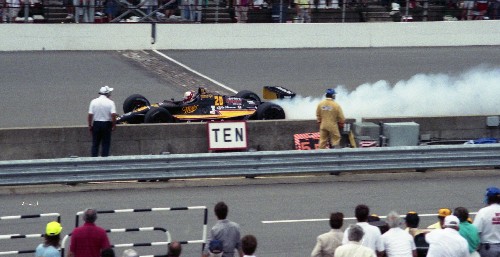
Danny Sullivan has just completed the last-ever lap with an Alfa Romeo engine at Indianapolis. (photo HG)
One week later at Milwaukee, Sullivan finished 5th in sponsor Miller's home race. Sullivan had finished the first six races in the points, scoring 36 points in the process. But in the following 11 races only five more point-scoring results followed. Sullivan added 20 more points and was classified 11th in the CART season standings. Danny was the highest ranking driver without the use of Chevy power. The first three drivers and seven of the top 10 drivers all used Lolas. It was obvious: the Lola T91/00 was no fluke.
It was, however, too little too late and at the end of the 1991 season Alfa Romeo announced its withdrawal from the CART series as a factory team. But should Patrick Racing find the funds to continue the program, Alfa would continue the project on a customer base and supply the engines. Needless to say Patrick wasnít interested.
With the Alfa CART project over and done, one bizarre statistic appeared in which our primary subject, the March 90CA, stood out. If we include the single outing with the March 88C hybrid in 1989, a total of five different types of chassis powered by Alfa Romeo engines have been used in CART. Since the hybrid 88C was used only once despite its lowly score (20th, after a first-lap crash), the 88C still scored its best result in its debut race. The odd fact is that the 1989 March-Alfa 89CE (8th), the 1990 Lola-Alfa T90/00 (5th) and the 1991 Lola-Alfa T91/00 (4th) all achieved the same feat: scoring their best finishing result ever in their debut race. The exception to the rule was (you've guessed it) the 1990 March-Alfa 90CA.
The end for the Alfa Romeo engine was inevitable anyway since 1992 would be the last year in which the engine could have been sensibly used. The arrival of the Ford Cosworth XB engine in 1992 showed the future. The new generation of engines were to be far more compact, lighter, lower, enabling far more aerodynamic cars. Although the Alfa V8 was described as being compact already, there was no way that the Alfa V8 in its current shape could ever match the XB dimensions. The entire generation of engines that had been built as an alternative to the Cosworth DFX was phased out during 1992 and 1993.
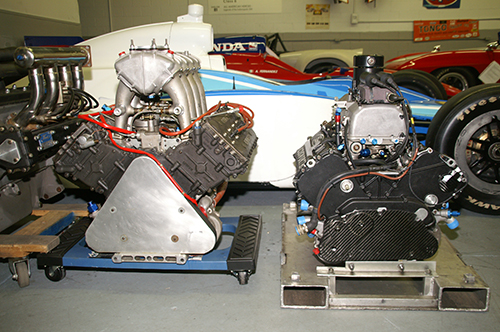
I admit, it isn't the best enviroment to take pictures like this but sometimes you can't complain when you got the chance to see the real things next to another. On the left is a Ford Cosworth DFX engine, an engine that was about the same size as the Alfa Indy V8. On the right is a Ford Cosworth XB engine that was introduced in 1992. The difference in frontal area and bulk for the actual engine blocks and potential that offered for the chassis designers is clear to see. (photo HG)
The rumoured Alfa Romeo Group C project was never seen in competition with a V8 derived from the CART engine, as had been regarded an option in late 1989. But then the car didnít appear either with a V10 engine derived from the ProCar V10, let alone with a newly developed V12. It transpired later on that a Group C car had indeed been built but eventually became yet another Alfa project that went straight into the museum.
In case this Group C car had indeed been a distraction at Alfacorse causing the team being less focused on the CART project, it certainly did a good job at that. Had it resulted into something substantial with results to boot there might have been something positive to say about it. But by now, having never been seen on any track at any event anywhere in the world, this Group C project canít be given any credits whatsoever and must be rated as a waste of time, efforts and money. And all of that possibly at the expense of the CART project.
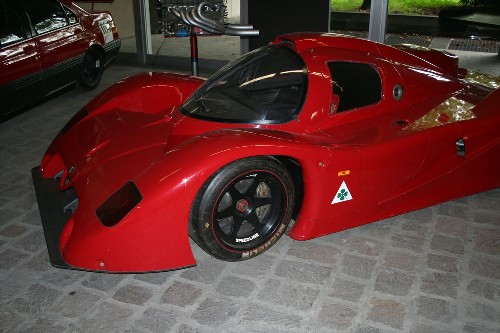
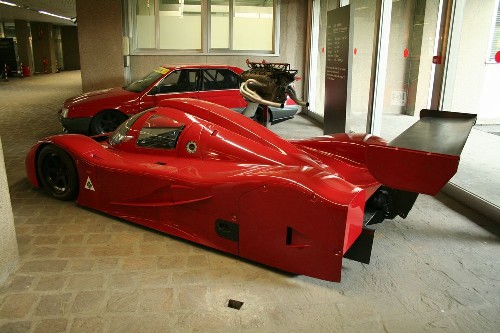
Thanks to Arjan de Roos for providing these pictures of the Alfa Gp.C car, as on display at the Alfa museum in 2007.
The remaining Alfa Romeo hardware went back to Italy, including several of the used chassis. At least two Lola T91/00 chassis were sold off. These chassis continued their careers for a while. One of the 89CEs went to Johnny Capels. When Capels made it clear that he wanted one of the cars, Alfa Romeo arranged that he got one in appreciation for his efforts in the early part of the project.
The next racing projects Alfa Romeo took up were in touring car racing with the front-wheel drive 155 saloon. And, this time, rather unusual for Alfa: with quite some success.
Alfa first derived a Class 1 2.5 litre V6-powered 4WD version, suitable for the ultra high-tech German Touring Championship (DTM). They made their debut in 1993 and Nicola Larini won the title for Alfa.
Then in 1994, Gabriele Tarquini won the hotly contested, prestigious British Touring Car Championship, held for the Class 2 category, which called for 2-litre cars. This title was perhaps even more prestigious since the Class 2 car came much closer to the production version of the car and was won against a much larger number of opposing constructors. Alfa Romeo had finally something to celebrateÖ
The aftermath for some others involved with the 90CA during 1990
Patrick Racing fired Danny Sullivan and hired Bobby Rahal for 1992. Patrick then contacted Ilmor-Chevrolet to lease their engines. But now it was pay-back time for Ilmor.
Two years before, Patrick had sent one Ilmor-Chevy engine (some sources say two) to Italy in order to give Alfa engineers an inside look on what was the best engine in the business. Of course, Ilmor got their hardware back but the damage was done. Ilmor adopted the strategy of leasing their engines so they remained their property, ensuring that Patrick was forever out of favour with Ilmor. Now was the time of Ilmor's revenge. Whether Rahal was involved or not, team owner Pat Patrick was denied the use of Ilmor-Chevrolet engines. No matter who he hired as a driver, no matter what team package he had to offer, he would get no engines. This was strictly personal, regardless at who else's expense it was. Come what may, there was to be no mercy for Patrick. Period.
So in order to allow Bobby Rahal to compete in the 1992 season, Patrick sold out to Rahal and his new partner Carl Hogan, the end of yet another incarnation of Patrick Racing. With Patrick out of the picture, when Rahal and Hogan contacted Ilmor about the availability of engines, they were more than welcome. The irony of ironies: Bobby became the 1992 CART champion!
Pat Patrick resurrected yet another team in 1994 that became the test team for the Firestone tyre company wanting to debut in CART racing in 1995. During Firestone's debut year driver Scott Pruett drove a great race at Indianapolis and was in contention for victory but crashed out late in the race. He made up for it by winning at Michigan in a thriller of a race, narrowly beating Al Unser Jr. And letís leave it here for the history of whatever reincarnation of Pat Patrick Racing.
Roberto Guerreroís career never came good after the Alfa debacle. One highlight remained for him as he qualified on pole with a new track record at Indy in 1992 driving a Kenny Bernstein-run Quaker State Lola-Buick. The race itself was a disaster: during a warm-up lap Roberto was weaving across the track on the back straight in order to get some heat into his tyres on a chilly day. To the everyone's amazement Roberto lost control, spun off and ended up in the infield, forced to retire even before the race had started!
Bernstein sold off his í92 cars and Guerrero was also released. In 1993 he was given a drive in one of the three King Motorsports Lola-Chevy C entries but he was one of only nine retirements in that particular race.
In 1994, Roberto ended up driving exactly the same Lola chassis he had qualified on pole two years previously, but as an elderly car it had no chance of making the front row. Nevertheless, Roberto qualified the car and this time he started the race. But the car seemed to have an appetite for last places because Roberto spun off early (into the wall this time) to become the first retirement in the race yet again.
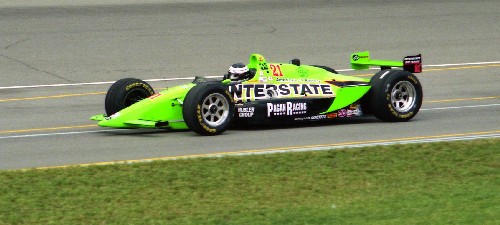
Roberto Guerrero in the Lola-Buick T92/00 he drove in both 1992 and 1994. They had won the pole in 1992 with new track records. This is the combo in 1994, at that time still the current track record holders. But Roberto finished 33rd and last in both years with the car. (photo HG)
Guerrero went on driving at Indy up until and into the IRL days but never gained anything like the results he scored in his first four years at the Speedway.
Al Unser Sr recovered from his crash at Michigan and tried to obtain a drive at Indianapolis in 1991. He even made himself available to Patrick Racing. But Guerrero took the ride instead and Unser never got another drive that year. He arrived at Indianapolis in 1992 driveless again, but took over a Team Menard Lola-Buick, originally assigned to Nelson Piquet who was unable to drive after a horrible accident. Unser finished third in the incident-packed race, the highest score ever for a Buick V6-engined car at Indianapolis and the first-ever time that such an engine completed 200 laps. He got a drive for 1993 with the Budweiser-sponsored King Motorsports team, thus becoming Roberto Guerrero's team mate yet again. He finished 12th, drove 199 laps and was the best of the three King Motorsports entries in the race, after yet another typical Al Unser Sr race: making the best of the situation he was in.
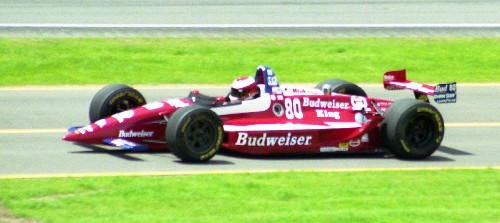
Al Unser Sr in his Lola-Chevy C on Carb Day 1993. Not his last year of activity ever at Indianapolis but this was the last car he ever drove in a race at the Speedway. (photo HG)
Al Sr drove during a few practice days during 1994 but during the second week of practice he all of a sudden gave up and retired as an active driver. He then got involved with the IRL as a driver coach.
At Granatelli Racing in 1991, Mo Nunn had a complicated season. During the season this team ran into financial problems hampering their results. Nevertheless, driver Arie Luyendyk won the 200-milers at the ovals of Phoenix and Nazareth (early and late in the season), was second at Michigan and third at Indy in the 500s of that year. Given the difficulties the team encountered, Granatelli Racing had an impressive season, no doubt courtesy the brilliance of Nunnís engineering skills. It was an approval of how hopeless the March-Alfa Romeo 90CA had been. One year later, with limited funds but with a good car/engine combination, Nunn could make a winner of the package he worked with in a field that was competitive with many possible winners every race.
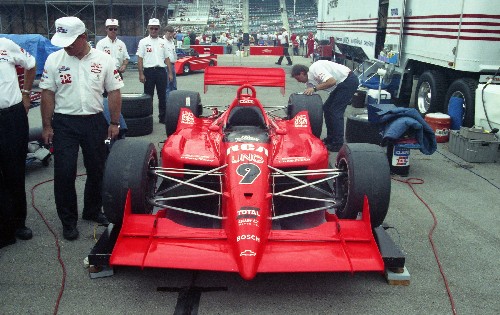
Arie Luyendijk's drive, the Vince Granatelli Racing Lola-Chevy T91/00, photographed in the paddock at Milwaukee 1991. Mo Nunn was Arie's chief engineer that year and together they were victorious twice: in the 200-mile oval events of Phoenix and Nazareth. (photo HG)
He remained active within for racing with ups and downs over the years and played an important part in the rise of Target Chip Ganassi Racing.
